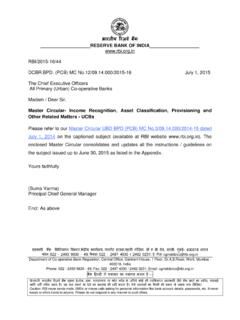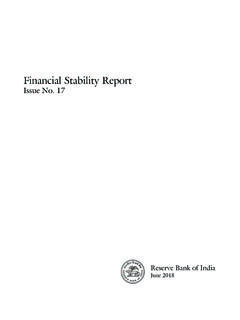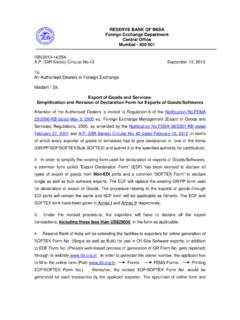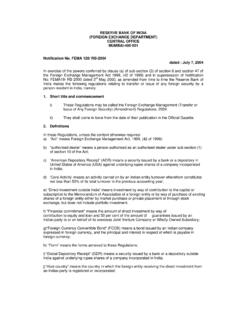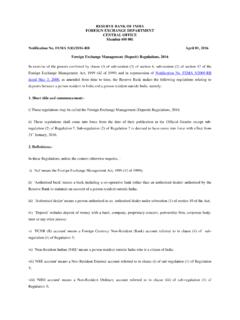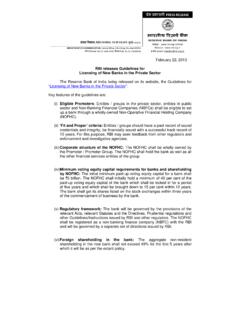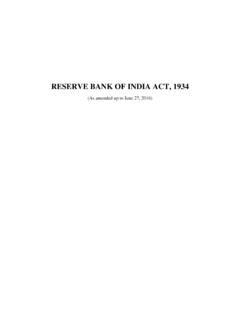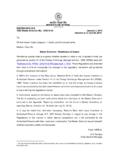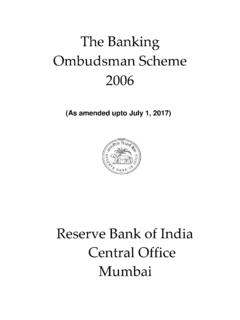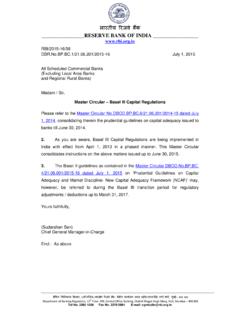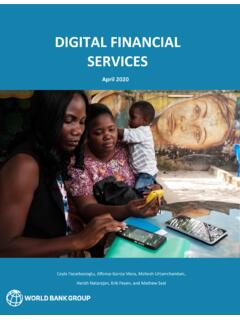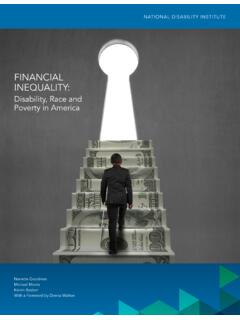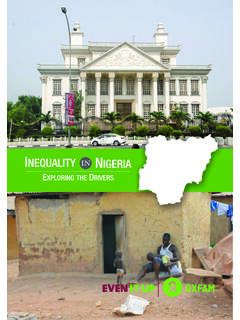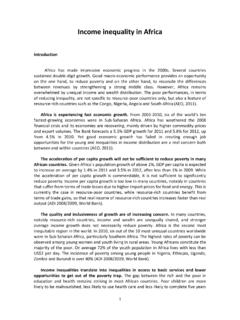Transcription of Financial Inclusion in India - Reserve Bank of India
1 Financial Inclusion in India An Assessment1 Overcoming poverty is not a gesture of charity. It is an act of justice. It is the protection of a fundamental human right, the right to dignity and a decent life. While poverty persists, there is no true freedom. Sometimes it falls upon a generation to be great. You can be that great generation. Let your greatness blossom. Of course, the task will not be easy. But not to do this would be a crime against humanity, against which I ask all humanity now to rise up." - Nelson Mandela The test of our progress is not whether we add more to the abundance of those who have much; it is whether we provide enough for those who have too little. - Franklin D. Roosevelt poverty is the worst form of violence. - Mahatma Gandhi If the misery of the poor be caused not by the laws of nature, but by our institutions, great is our sin.
2 - Charles Darwin Introduction The Government of India and the Reserve Bank of India have been making concerted efforts to promote Financial Inclusion as one of the important national objectives of the country. Some of the major efforts made in the last five decades include - nationalization of banks, building up of robust branch network of scheduled commercial banks, co-operatives and regional rural banks, introduction of mandated priority sector lending targets, lead bank scheme, formation of self-help groups, permitting BCs/BFs to be appointed by banks to provide door step delivery of banking services, zero balance BSBD accounts, etc. The fundamental objective of all these initiatives is to reach the large sections of the hitherto financially excluded Indian population. The speech is organized infive sections: Section 1 - Definitions Section 2 - Extent of Financial Exclusion Section 3 RBI Policy Initiatives and Progress in Financial Inclusion Section 4 Stakeholder-wise Issues in Financial Inclusion Section 5 Conclusion and Way forward 1 1 The assistance provided by Shri M.
3 Sreeramulu, AGM, DNBS, RBI, CO is heartily acknowledged. Section - 1 Definitions Financial Inclusion may be defined as the process of ensuring access to Financial services and timely and adequate credit where needed by vulnerable groups such as weaker sections and low income groups at an affordable cost (The Committee on Financial Inclusion , Chairman: Dr. C. Rangarajan). Financial Inclusion , broadly defined, refers to universal access to a wide range of Financial services at a reasonable cost. These include not only banking products but also other Financial services such as insurance and equity products (The Committee on Financial Sector Reforms, Chairman: G. Rajan). Household access to Financial services is depicted in Figure I. Figure I: Household Access to Financial Services Source: A Hundred Small Steps - Report of the Committee on Financial Sector Reforms (Chairman : Dr.)
4 RaghuramRajan), The essence of Financial Inclusion is to ensure delivery of Financial services which include - bank accounts for savings and transactional 2 purposes, low cost credit for productive, personal and other purposes, Financial advisory services, insurance facilities (life and non-life) etc. Why Financial Inclusion ? Financial Inclusion broadens the resource base of the Financial system by developing a culture of savings among large segment of rural population and plays its own role in the process of economic development. Further, by bringing low income groups within the perimeter of formal banking sector; Financial Inclusion protects their Financial wealth and other resources in exigent circumstances. Financial Inclusion also mitigates the exploitation of vulnerable sections by the usurious money lenders by facilitating easy access to formal credit.
5 In rural areas, the Gini s2 coefficient rose to in 2011-12 from in 2004-05 and during the same period to an all-time high of from in urban areas. Section 2 Extent of Financial Exclusion In this section, the extent of Financial exclusion from different perspectives / angularities is presented based on five different data sources viz.: (a) NSSO 59thRound Survey Results, (b) Government of India Population Census 2011, (c) CRISIL-Inclusix (d) RBI Working Paper Series Study on Financial Inclusion in India : A Case-study of West Bengal and (e) World Bank Financial Access Survey Results. 2 Source: National Sample Survey on household consumption expenditure. The coefficient ranges from zero to one, with zero representing perfect equality and one showing perfect inequality . 3 NSSO 59th Round Survey Results3 of farmer households are financially excluded from both formal/ informal sources.
6 Of the total farmer households, only 27% access formal sources of credit; one third of this group also borrowed from non-formal sources. Overall, 73% of farmer households have no access to formal sources of credit. Across regions, Financial exclusion is more acute in Central, Eastern and North-Eastern regions. All three regions together accounted for 64% of all financially excluded farmer households in the country. Overall indebtedness to formal sources of finance of these three regions accounted for only However, over the period of five decades, there has been overall improvement in access to formal sources4 of credit by the rural households (Chart 1). Chart 1: Access to Formal and Informal Sources Government of India Population Census 2011 As per census 2011, only of households are availing banking services in the country.
7 However, as compared with previous 3 All India Debt and Investment Survey, NSSO 59th Round 4 Formal sources include credit from SCBs (including RRBs) and credit from Co op society/bank and informal sources include credit from agricultural and professional money lenders. 4 census 2001, availing of banking services increased significantly largely on account of increase in banking services in rural areas (Chart 2). Chart 2: Availing of Banking Services (Per Cent)Availing of Banking ServicesCensus 2001 Census 2011 Source: Department of Financial Services, GoI CRISIL Financial Inclusion Index (Inclusix) In June 2013, CRISIL first time published a comprehensive Financial Inclusion index (viz.,Inclusix). For constructing the index, CRISIL identified three critical parameters of basic banking services namely branch penetration5, deposit penetration6 and credit penetration7.
8 The CRISIL Inclusix indicate that there is an overall improvement in the Financial Inclusion in India (Chart 3). CRISIL Inclusix (on a scale of 100) increased from March 2009 to in March 2010 and to in March 2011. Chart 3: CRISIL - Inclusix : CRISILI nclusix 5 Bank branch penetration is measured as number of bank branches per one lakh population 6 Measured as number of saving deposit accounts per one lakh population 7 Average of three measures (namely number of loan accounts per one lakh population, number of small borrower loan accounts per one lakh population and number of agriculture advances per one lakh population) used for credit penetration. 5 RBI Working Paper Study Sadhan Kumar8 (2011) worked out an Index on Financial Inclusion (IFI) based on three variables namely penetration (number of adults having bank account), availability of banking services (number of bank branches per 1000 population) and usage (measured as outstanding credit and deposit).
9 The results indicate that Kerala, Maharashtra and Karnataka has achieved high Financial Inclusion (IFI > ), while Tamil Nadu, Punjab, , , Sikkim, and Haryana identified as a group of medium Financial Inclusion ( <IFI< ) and the remaining states have very low Financial Inclusion . World Bank Financial Access Survey Results From the table 1 given below, it would be observed that in our country, Financial exclusion measured in terms of bank branch density, ATM density, bank credit to GDP and bank deposits to GDP is quite low as compared with most of developing countries in the world. Table 1: Select Indicators of Financial Inclusion , 2011 Number of Bank BranchesNumber of ATMsNumber of Bank BranchesNumber of ATMsBank DepositsBank South Sri : Financial Access Survey, IMF; Figures in respect of UK are as on CountryPer 1000 KMPer Millionas % to GDP 8 RBI Working Paper Series (WPS (DEPR):8/2011), Sadhan Kumar Chattopadhyay 6 Section 3 Financial Inclusion RBI Policy Initiatives RBI has adopted a bank-led model for achieving Financial Inclusion and removed all regulatory bottle necks in achieving greater Financial Inclusion in the country.
10 Further, for achieving the targeted goals, RBI has created conducive regulatory environment and provided institutional support for banks in accelerating their Financial Inclusion efforts (Box-I). Box-I : Financial Inclusion Initiatives Advised all banks to open Basic Saving Bank Deposit (BSBD) accounts with minimum common facilities such as no minimum balance, deposit and withdrawal of cash at bank branch and ATMs, receipt/ credit of money through electronic payment channels, facility of providing ATM card. Relaxed and simplified KYC norms to facilitate easy opening of bank accounts, especially for small accounts with balances not exceeding Rs. 50,000 and aggregate credits in the accounts not exceeding Rs. one lakh a year. Further, banks are advised not to insist on introduction for opening bank accounts of customers.
